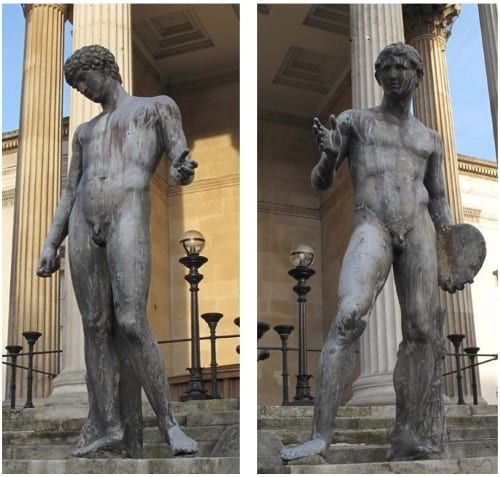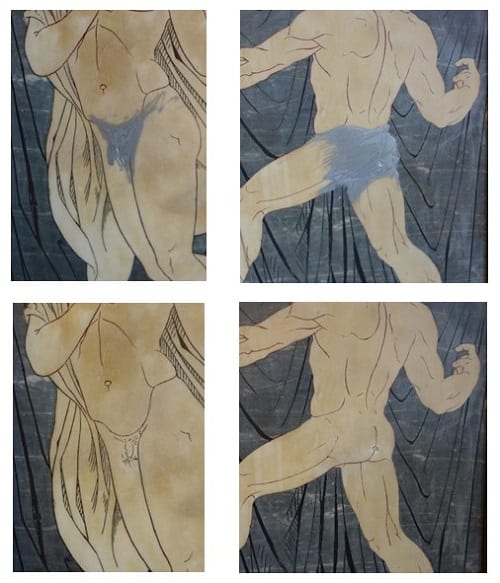Conservation of Public Art in the UCL Wilkins Building
By Susi Pancaldo, on 11 March 2016
Have you ever noticed – as you hurry off to class, the library or an event – that UCL’s campus is filled with works of art?
The Wilkins Building, at the heart of the UCL Bloomsbury campus’ main quad, is particularly rich in sculpture. Outside the building, of course, are the iconic lead athletes on the steps below the dome.
These figures have a fascinating history and I will write more about them another time.
Inside the Wilkins Building, there is an abundance of works on permanent display too. Adjacent to the Jeremy Bentham auto-icon are two large, ancient Egyptian limestone lions in excavated by Sir Wm.M.F. Petrie. There are a number of 19th and early 20th century sculptures on either side of the Octagon Gallery; wall paintings in the Whistler Room (soon to be opened to the public); and upstairs, within the library, a myriad of sculpture in and around the 1st floor Flaxman Gallery.
All of these works of art are looked after by UCL PACE staff in partnership with UCL Estates and Facilities. UCL Art Museum has a prominent role in particular and I am are currently working with my colleagues to establish a regular conservation maintenance programme for Wilkins Building sculpture.
Sometimes more than maintenance is required, though! A case in point: About a year ago, I was called in to investigate graffiti that appeared overnight on ‘Marmor Homericum,’ the large work on display at the north end of the South Cloisters. This work, UCL’s first public art commission, was made between 1863-65 specifically for the Wilkins Building by the French sculptor, Henri de Triqueti. The work was made using pietra dure, using variously coloured hardstone, and sgraffitto, in which coloured paste of some sort (not yet identified) was laid into exquistely cut lines. You can read more about the origins of the ‘Marmor Homericum’ here.
Security cameras in the South Cloisters revealed two people, in the middle of the night, decided to deface two of figures on the lower border — Mercury on the left, and a male Archer on the right. The vandals gave the figures underwear! Silver paint was applied with what appears to have been a thick, felt-tip pen.
Fortunately, this act of vandalism was easily remedied, as the paint lifted off by rolling swabs of cotton dampened with petroleum solvents over it.
Working on this sculpture gave me a chance to re-examine this work up close. A number of questions have been raised about Triqueti’s materials and his working methods. There are also questions about the wall mural’s overall physical condition. For instance, why are the upper regions of the image stained dark orange, and is this damage actively occuring or was the discolouration caused by a problem in the past? Plans are now underway to commission a full conservation investigation of this important work and I hope to be able to report on discoveries in future blogs.
2 Responses to “Conservation of Public Art in the UCL Wilkins Building”
- 1
-
2
Eric Rasmussen wrote on 20 October 2021:
Susi Pancaldo,
I would love to know more of the history of the lead statues. Did you ever get to writing more about them on this blog or elsewhere?
Olivia Hart,
I am also wondering what you were able to uncover about them.
The master’s thesis I am writing looks at dramatic narratives, one of which, the Nigel Finch film “The Lost Language of Cranes” contains a scene in which the statue of Discophorus is featured.
Any tips that either of you might have about where to learn more about the history of these particular reproductions would be greatly appreciated.
All the best,
Eric
 Close
Close






Hi, I was just wondering if you had any information on the two lead statues in the main quad? I am doing an essay which includes them but am struggling to find much information on these copies of the originals. Thank you